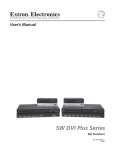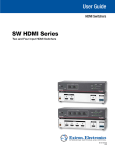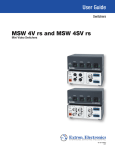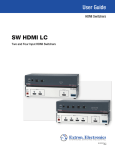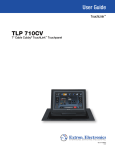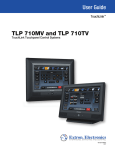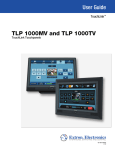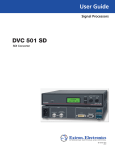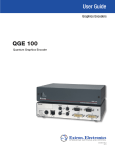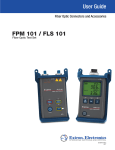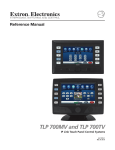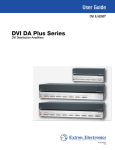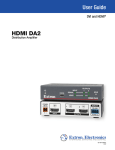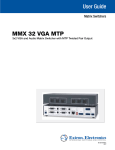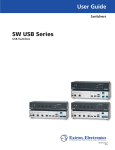Download Extron electronics SW4 DVI Plus User guide
Transcript
User Guide DVI Switchers SW DVI Plus Series DVI Switchers 68-1316-02 Rev. D 03 12 Safety Instructions • English Warning This symbol is intended to alert the user of important operating and maintenance (servicing) instructions in the literature provided with the equipment. Power sources • This equipment should be operated only from the power source indicated on the product. This equipment is intended to be used with a main power system with a grounded (neutral) conductor. The third (grounding) pin is a safety feature, do not attempt to bypass or disable it. This symbol is intended to alert the user of the presence of uninsulated dangerous voltage within the product’s enclosure that may present a risk of electric shock. Power disconnection • To remove power from the equipment safely, remove all power cords from the rear of the equipment, or the desktop power module (if detachable), or from the power source receptacle (wall plug). Caution Read Instructions • Read and understand all safety and operating instructions before using the equipment. Retain Instructions • The safety instructions should be kept for future reference. Follow Warnings • Follow all warnings and instructions marked on the equipment or in the user information. Avoid Attachments • Do not use tools or attachments that are not recommended by the equipment manufacturer because they may be hazardous. Consignes de Sécurité • Français Ce symbole sert à avertir l’utilisateur que la documentation fournie avec le matériel contient des instructions importantes concernant l’exploitation et la maintenance (réparation). Ce symbole sert à avertir l’utilisateur de la présence dans le boîtier de l’appareil de tensions dangereuses non isolées posant des risques d’électrocution. Attention Lire les instructions• Prendre connaissance de toutes les consignes de sécurité et d’exploitation avant d’utiliser le matériel. Conserver les instructions• Ranger les consignes de sécurité afin de pouvoir les consulter à l’avenir. Respecter les avertissements • Observer tous les avertissements et consignes marqués sur le matériel ou présentés dans la documentation utilisateur. Eviter les pièces de fixation • Ne pas utiliser de pièces de fixation ni d’outils non recommandés par le fabricant du matériel car cela risquerait de poser certains dangers. Sicherheitsanleitungen • Deutsch Power cord protection • Power cords should be routed so that they are not likely to be stepped on or pinched by items placed upon or against them. Servicing • Refer all servicing to qualified service personnel. There are no user-serviceable parts inside. To prevent the risk of shock, do not attempt to service this equipment yourself because opening or removing covers may expose you to dangerous voltage or other hazards. Slots and openings • If the equipment has slots or holes in the enclosure, these are provided to prevent overheating of sensitive components inside. These openings must never be blocked by other objects. Lithium battery • There is a danger of explosion if battery is incorrectly replaced. Replace it only with the same or equivalent type recommended by the manufacturer. Dispose of used batteries according to the manufacturer’s instructions. Avertissement Alimentations • Ne faire fonctionner ce matériel qu’avec la source d’alimentation indiquée sur l’appareil. Ce matériel doit être utilisé avec une alimentation principale comportant un fil de terre (neutre). Le troisième contact (de mise à la terre) constitue un dispositif de sécurité : n’essayez pas de la contourner ni de la désactiver. Déconnexion de l’alimentation• Pour mettre le matériel hors tension sans danger, déconnectez tous les cordons d’alimentation de l’arrière de l’appareil ou du module d’alimentation de bureau (s’il est amovible) ou encore de la prise secteur. Protection du cordon d’alimentation • Acheminer les cordons d’alimentation de manière à ce que personne ne risque de marcher dessus et à ce qu’ils ne soient pas écrasés ou pincés par des objets. Réparation-maintenance • Faire exécuter toutes les interventions de réparation-maintenance par un technicien qualifié. Aucun des éléments internes ne peut être réparé par l’utilisateur. Afin d’éviter tout danger d’électrocution, l’utilisateur ne doit pas essayer de procéder lui-même à ces opérations car l’ouverture ou le retrait des couvercles risquent de l’exposer à de hautes tensions et autres dangers. Fentes et orifices • Si le boîtier de l’appareil comporte des fentes ou des orifices, ceux-ci servent à empêcher les composants internes sensibles de surchauffer. Ces ouvertures ne doivent jamais être bloquées par des objets. Lithium Batterie • Il a danger d’explosion s’ll y a remplacment incorrect de la batterie. Remplacer uniquement avec une batterie du meme type ou d’un ype equivalent recommande par le constructeur. Mettre au reut les batteries usagees conformement aux instructions du fabricant. Vorsicht Dieses Symbol soll dem Benutzer in der im Lieferumfang enthaltenen Dokumentation besonders wichtige Hinweise zur Bedienung und Wartung (Instandhaltung) geben. Stromquellen • Dieses Gerät sollte nur über die auf dem Produkt angegebene Stromquelle betrieben werden. Dieses Gerät wurde für eine Verwendung mit einer Hauptstromleitung mit einem geerdeten (neutralen) Leiter konzipiert. Der dritte Kontakt ist für einen Erdanschluß, und stellt eine Sicherheitsfunktion dar. Diese sollte nicht umgangen oder außer Betrieb gesetzt werden. Dieses Symbol soll den Benutzer darauf aufmerksam machen, daß im Inneren des Gehäuses dieses Produktes gefährliche Spannungen, die nicht isoliert sind und die einen elektrischen Schock verursachen können, herrschen. Stromunterbrechung • Um das Gerät auf sichere Weise vom Netz zu trennen, sollten Sie alle Netzkabel aus der Rückseite des Gerätes, aus der externen Stomversorgung (falls dies möglich ist) oder aus der Wandsteckdose ziehen. Achtung Lesen der Anleitungen • Bevor Sie das Gerät zum ersten Mal verwenden, sollten Sie alle Sicherheits-und Bedienungsanleitungen genau durchlesen und verstehen. Aufbewahren der Anleitungen • Die Hinweise zur elektrischen Sicherheit des Produktes sollten Sie aufbewahren, damit Sie im Bedarfsfall darauf zurückgreifen können. Befolgen der Warnhinweise • Befolgen Sie alle Warnhinweise und Anleitungen auf dem Gerät oder in der Benutzerdokumentation. Keine Zusatzgeräte • Verwenden Sie keine Werkzeuge oder Zusatzgeräte, die nicht ausdrücklich vom Hersteller empfohlen wurden, da diese eine Gefahrenquelle darstellen können. Instrucciones de seguridad • Español Este símbolo se utiliza para advertir al usuario sobre instrucciones importantes de operación y mantenimiento (o cambio de partes) que se desean destacar en el contenido de la documentación suministrada con los equipos. Este símbolo se utiliza para advertir al usuario sobre la presencia de elementos con voltaje peligroso sin protección aislante, que puedan encontrarse dentro de la caja o alojamiento del producto, y que puedan representar riesgo de electrocución. Precaucion Leer las instrucciones • Leer y analizar todas las instrucciones de operación y seguridad, antes de usar el equipo. Conservar las instrucciones • Conservar las instrucciones de seguridad para futura consulta. Obedecer las advertencias • Todas las advertencias e instrucciones marcadas en el equipo o en la documentación del usuario, deben ser obedecidas. Evitar el uso de accesorios • No usar herramientas o accesorios que no sean especificamente recomendados por el fabricante, ya que podrian implicar riesgos. 安全须知 • 中文 这个符号提示用户该设备用户手册中有重要的操作和维护说明。 这个符号警告用户该设备机壳内有暴露的危险电压,有触电危险。 注意 阅读说明书 保存说明书 遵守警告 • 避免追加 • • 用户使用该设备前必须阅读并理解所有安全和使用说明。 • 用 户应保存安全说明书以备将来使用。 用户应遵守产品和用户指南上的所有安全和操作说明。 不要使用该产品厂商没有推荐的工具或追加设备,以避免危险。 Schutz des Netzkabels • Netzkabel sollten stets so verlegt werden, daß sie nicht im Weg liegen und niemand darauf treten kann oder Objekte darauf- oder unmittelbar dagegengestellt werden können. Wartung • Alle Wartungsmaßnahmen sollten nur von qualifiziertem Servicepersonal durchgeführt werden. Die internen Komponenten des Gerätes sind wartungsfrei. Zur Vermeidung eines elektrischen Schocks versuchen Sie in keinem Fall, dieses Gerät selbst öffnen, da beim Entfernen der Abdeckungen die Gefahr eines elektrischen Schlags und/oder andere Gefahren bestehen. Schlitze und Öffnungen • Wenn das Gerät Schlitze oder Löcher im Gehäuse aufweist, dienen diese zur Vermeidung einer Überhitzung der empfindlichen Teile im Inneren. Diese Öffnungen dürfen niemals von anderen Objekten blockiert werden. Litium-Batterie • Explosionsgefahr, falls die Batterie nicht richtig ersetzt wird. Ersetzen Sie verbrauchte Batterien nur durch den gleichen oder einen vergleichbaren Batterietyp, der auch vom Hersteller empfohlen wird. Entsorgen Sie verbrauchte Batterien bitte gemäß den Herstelleranweisungen. Advertencia Alimentación eléctrica • Este equipo debe conectarse únicamente a la fuente/tipo de alimentación eléctrica indicada en el mismo. La alimentación eléctrica de este equipo debe provenir de un sistema de distribución general con conductor neutro a tierra. La tercera pata (puesta a tierra) es una medida de seguridad, no puentearia ni eliminaria. Desconexión de alimentación eléctrica • Para desconectar con seguridad la acometida de alimentación eléctrica al equipo, desenchufar todos los cables de alimentación en el panel trasero del equipo, o desenchufar el módulo de alimentación (si fuera independiente), o desenchufar el cable del receptáculo de la pared. Protección del cables de alimentación • Los cables de alimentación eléctrica se deben instalar en lugares donde no sean pisados ni apretados por objetos que se puedan apoyar sobre ellos. Reparaciones/mantenimiento • Solicitar siempre los servicios técnicos de personal calificado. En el interior no hay partes a las que el usuario deba acceder. Para evitar riesgo de electrocución, no intentar personalmente la reparación/mantenimiento de este equipo, ya que al abrir o extraer las tapas puede quedar expuesto a voltajes peligrosos u otros riesgos. Ranuras y aberturas • Si el equipo posee ranuras o orificios en su caja/alojamiento, es para evitar el sobrecalientamiento de componentes internos sensibles. Estas aberturas nunca se deben obstruir con otros objetos. Batería de litio • Existe riesgo de explosión si esta batería se coloca en la posición incorrecta. Cambiar esta batería únicamente con el mismo tipo (o su equivalente) recomendado por el fabricante. Desachar las baterías usadas siguiendo las instrucciones del fabricante. 警告 电源 • 该设备只能使用产品上标明的电源。 设备必须使用有地线的供电系统供电。 第三条线( 地线)是安全设施,不能不用或跳过 。 拔掉电源 • 为安全地从设备拔掉电源,请拔掉所有设备后或桌面电源的电源线,或任何接到市电 系统的电源线。 电源线保护 • 妥善布线, 避免被踩踏,或重物挤压。 维护 • 所有维修必须由认证的维修人员进行。 设备内部没有用户可以更换的零件。为避免出现触 电危险不要自己试图打开设备盖子维修该设备。 通风孔 • 有些设备机壳上有通风槽或孔,它们是用来防止机内敏感元件过热。 不要用任何东西 挡住通风孔。 锂电池 • 不正确的更换电池会有爆炸的危险。必须使用与厂家推荐的相同或相近型号的电池。按 照生产厂的建议处理废弃电池。 FCC Class A Notice This equipment has been tested and found to comply with the limits for a Class A digital device, pursuant to part 15 of the FCC Rules. Operation is subject to the following two conditions: 1. This device may not cause harmful interference. 2. This device must accept any interference received, including interference that may cause undesired operation. The Class A limits are designed to provide reasonable protection against harmful interference when the equipment is operated in a commercial environment. This equipment generates, uses, and can radiate radio frequency energy and, if not installed and used in accordance with the instruction manual, may cause harmful interference to radio communications. Operation of this equipment in a residential area is likely to cause harmful interference, in which case the user will be required to correct the interference at his own expense. NOTE: This unit was tested with shielded cables on the peripheral devices. Shielded cables must be used with the unit to ensure compliance with FCC emissions limits. For more information on safety guidelines, regulatory compliances, accessibility, and related topics, click here. Conventions Used in this Guide Notifications In this user guide, the following are used: CAUTION: A caution indicates a potential hazard to equipment or data. NOTE: A note draws attention to important information. TIP: A tip provides a suggestion to make working with the application easier. WARNING: A warning warns of things or actions that might cause injury, death, or other severe consequences. Software Commands Commands are written in the fonts shown here: ^AR Merge Scene,,Op1 scene 1,1 ^B 51 ^W^C [01] R 0004 00300 00400 00800 00600 [02] 35 [17] [03] E X! *X1&* X2)* X2#* X2! CE} NOTE: For commands and examples of computer or device responses mentioned in this guide, the character “0” is used for the number zero and “O” represents the capital letter “o.” Computer responses and directory paths that do not have variables are written in the font shown here: Reply from 208.132.180.48: bytes=32 times=2ms TTL=32 C:\Program Files\Extron Variables are written in slanted form as shown here: ping xxx.xxx.xxx.xxx —t SOH R Data STX Command ETB ETX Selectable items, such as menu names, menu options, buttons, tabs, and field names are written in the font shown here: From the File menu, select New. Click the OK button. Copyright © 2012 Extron Electronics. All rights reserved. Trademarks All trademarks mentioned in this guide are the properties of their respective owners. Contents Introduction............................................................ 1 Remote Configuration and Control................. 18 About this Guide................................................. 1 About the SW DVI Plus Series............................... 1 Features............................................................... 2 Application Diagrams........................................... 3 Using Simple Instruction Set (SIS) Commands..... 18 Host-to-switcher Communications................. 18 Switcher-initiated Messages........................... 18 Error Responses............................................. 19 Using the Command and Response Table....... 19 Symbol Definitions......................................... 19 Command and Response Table for SIS Commands................................................... 20 Universal Switcher Control Program................... 23 Installing the Software from the DVD............. 23 Starting the Program...................................... 24 Using the Help System................................... 25 Updating Firmware Using Firmware Loader........ 25 Downloading and Installing Firmware Loader........................................... 25 Downloading the SW DVI Plus Firmware........ 26 Loading the Firmware to the Switcher............ 27 Installation .............................................................. 4 Installation Overview............................................ 4 Rear Panel Features.............................................. 5 Wiring the Power Connector............................... 7 Wiring the Audio Connectors (SW DVI A Plus Models).............................................................. 8 Audio Input..................................................... 8 Audio Output.................................................. 9 Wiring for RS-232 Control................................... 9 SW2 and SW4 DVI Plus (RS-232 Connector)..... 9 All Other Models (Remote/Auto-SW Connector)..................................................... 9 Enabling Auto-input Switching.......................... 10 SW2/SW4 DVI Plus (Non-audio) Models......... 10 All Other Models............................................ 10 Operation ............................................................. 12 Front Panel Features........................................... 12 Operations........................................................ 13 Powering On the Switcher............................. 13 Selecting an Input.......................................... 13 Using the Optional IR 102 Remote Control..... 14 Enabling Front Panel Lockout (Executive Mode).......................................... 15 Setting Equalization for Input Sources............ 15 EDID Modes................................................... 15 Resetting....................................................... 17 Reference Information........................................ 31 Specifications..................................................... 31 Part Numbers..................................................... 34 Included Parts................................................ 34 Accessories.................................................... 34 Cables and Adapters...................................... 34 Mounting the SW DVI Plus Switcher................... 35 Tabletop use.................................................. 35 Rack mounting.............................................. 35 Furniture Mounting (SW2 and SW4 DVI Plus Only)............................................................. 38 SW DVI Plus Series • Contents v SW DVI Plus Series • Contents vi Introduction This section gives an overview of the Extron SW DVI Plus Series switchers, describes their significant features, and provides examples of application diagrams. The following topics are covered: • About this Guide • About the SW DVI Plus Series • Features • Application Diagrams About this Guide This guide describes the SW DVI Plus Series switchers and discusses how to install, configure, and operate them. In this guide, the term “SW DVI Plus Series” refers to all SW DVI Plus models, with or without audio. “Switcher” and “SW DVI Plus” are used interchangeably to refer to any single unit. The SW DVI Plus Series consists of the following eight models: SW2 DVI Plus SW2 DVI A Plus SW4 DVI Plus SW4 DVI A Plus SW6 DVI Plus SW6 DVI A Plus SW8 DVI Plus SW8 DVI A Plus The number following SW indicates the number of inputs; “A” indicates an audio product. For example, the SW6 DVI A Plus is a six-input switcher with audio. About the SW DVI Plus Series The Extron SW DVI Plus Series are two, four, six, and eight input, one output, single-link Digital Visual Interface (DVI) switchers that select among multiple DVI-D video input signals to output to a single compatible display device. The SW DVI A Plus switchers additionally switch audio signals. All switchers accept and route computer resolutions of up to 1920x1200 or 1080p @ 60 Hz and have pixel bandwidths of up to 165 MHz. The SW DVI Plus switchers can be controlled via the front panel, the RS-232 interface, or the optional IR 102 Remote Control. You can select inputs by pressing the front panel buttons, enabling auto-input switching, entering Simple Instruction Set (SIS™) commands via RS-232, or pressing buttons on the IR 102. NOTE: The SW DVI Plus Series switchers are not compatible with HDCP (High-bandwidth Digital Content Protection) signals. If the display device exhibits a flashing black or blue screen, snow, or other display distortion, it may be receiving an HDCP-encrypted signal. SW DVI Plus Series • Introduction 1 Features • Auto-input switching — The SW DVI Plus Series can be configured to automatically switch to the active input when the switcher detects a signal. If multiple input signals are present, the switcher switches to the highest numbered active input. • Signal detection LEDs — Each input is represented by an LED on the front panel. Each LED lights if a signal is present for its input. • Independent input equalization — High or low equalization levels for each input can be selected via the Input EQ DIP switches on the front panel. This reduces the need for additional signal conditioning equipment to compensate for a degraded or poor quality signal. • EDID Minder — EDID (Extended Display Identification Data) consists of the resolution, refresh rate, and pixel clock information of a display device. The EDID Minder manages this information between the digital output device and all the input sources. By maintaining continuous EDID communication with all input sources, the EDID Minder ensures that all DVI sources power up properly and maintain their video outputs, whether or not an active signal is displayed. Either of the following EDID modes can be selected by SIS commands: • Automatic, in which the SW DVI Plus reads the EDID data when a display is connected and stores the data in memory (default mode) • User-assigned, in which you can assign one of 15 factory-provided files of EDID information to each input. The EDID does not change if a different display device is connected. This mode is useful for trouble-shooting purposes. Each time power is applied to the output device or the display is replaced, the SW DVI Plus either reads the EDID information from the display or reloads the user-assigned EDID information. It then writes the information to non-volatile memory on the inputs. The input devices can read this information as they reboot (see “EDID Modes” in the “Operation” section for more information). • Power supply — An external 12 VDC power supply with a 2-pole captive screw connector accepts 100 to 240 VAC. • Rack and furniture mounting — The SW DVI Plus Series can be mounted on a rack shelf or under a desk or podium with an optional mounting kit. • RS-232 control — The switcher can be controlled via SIS commands issued through an RS-232 computer interface. • IR remote control (optional) — The hand-held IR 102 Remote Control can control the SW DVI Plus via infrared signals that it sends to the switcher from a distance of up to 30 feet (9 m). • Front panel security lockout (executive mode) — To prevent unauthorized access to the switchers, front panel lock mode can be enabled via the front panel or SIS commands. When the switcher is in lock mode, all front panel controls are disabled (RS-232 and IR control remain available). • Universal Switcher Control Program — The Windows®-based Extron Universal Switcher Control Program, which communicates with the switcher via the RS-232 port (non-audio SW2 and SW4 models) or the Remote/Auto-SW port (all other models), provides an alternative way to configure and operate the SW DVI Plus switcher. The program is compatible with Windows 2000, Windows XP, Windows 7, or higher versions. SW DVI Plus Series • Introduction 2 Application Diagrams The following diagrams provide examples of how an SW DVI Plus Series switcher can be connected. RS-232 Control PCs with DVI Output -232 RS UT TP I-D DV OU 4 I-D DV UTS INP 3 2 S VI 4D SW PLU 1 WER POV X 12 MA A 0.4 Extron SW4 DVI Plus DVI Switcher Display with DVI Input PCs with DVI Output Figure 1. Connection Diagram for an SW4 DVI Plus Switcher Extron XPA 1002 Power Amplifier 02 A 10 XP PUT2 OUT 1 OTE mA REM 50 UTE ING SS 10V VOL/M 2 WIR CLA UTS2 INP 1 DBY STAN EL 2 LEV 1 Hz 50-60 0.5A, 40V 100-2 US T 17T O C ED IDE LISTIO/V TUS / ITER T AUD ARA LIM TEC APP PRO NAL SIG 1 2 0 0 Extron SI 26 Control System Extron SW8 DVI A Plus DVI Switcher with Audio Two Way Surface Mount Speakers IA 8 DV US PL SW -SW TO R L DIO / AUT I-D DV OUTPU TE / AU MO RE AS Tx Rx RS-232 8 7 6 TS I/ DIO INPU 5 AU DV 4 3 2 1 WE PO R X 12V MA A 0.4 Projector with DVI In DVI PC with DVI Out Laptop with DVI Out PC with DVI Out Figure 2. Connection Diagram for an SW8 DVI A Plus Switcher SW DVI Plus Series • Introduction 3 Installation This section gives an overview of the steps to install the SW DVI Plus switchers and detailed instructions for cabling. It also provides a description of the rear panel connectors. The following topics are covered: • Installation Overview • Rear Panel Features • Wiring the Power Connector • Wiring the Audio Connectors (SW DVI A Plus Models) • Wiring for RS-232 Control • Enabling Auto-input Switching Installation Overview To install and set up the SW DVI Plus switcher: 1. Mount the switcher on a rack shelf or furniture, if desired. 2. Connect input sources to one or more SW DVI Plus video input connectors. 3. Connect an output device to the DVI output connector of the switcher. 4. (SW DVI A Plus models only) Plug the audio connectors of your input devices into the 3.5 mm TRS audio input jacks of the switcher. 5. (SW DVI A Plus models only) Connect the audio input of your display device to the audio output connector of the switcher (see “Wiring the Audio Connector [SW DVI A Plus]” on page 8). 6. Connect the RS-232 port of your computer to pins 1, 2, and 3 of the Remote/Auto-SW connector of the switcher (see “Wiring for RS-232 Control”on page 9). 7. (Optional; all models except non-audio SW2 and SW4 DVI Plus) To enable auto-input switching, use a jumper to connect pins 4 and 5 of the Remote/Auto-SW connector (see “Enabling Auto-input Switching”on page 10). 8. If necessary, wire a 2-pole captive screw connector to the external power supply (see “Wiring the Power Connector”on page 7). 9. Power on the output display. 10. Connect power to the switcher. 11. Power on the input devices. SW DVI Plus Series • Installation 4 Rear Panel Features 3 RS-232 SW2 DVI Plus POWER 12V 0.2A MAX DVI-D INPUTS 1 2 DVI-D OUTPUT 7 2 1 Figure 3. SW2 DVI Plus Rear Panel 4 2 1 INPUTS SW2 DVI A Plus OUTPUT REMOTE / AUTO-SW INPUTS 1 POWER 12V 0.5A MAX Tx Rx AS 1 OUTPUT 2 L 2 R 7 5 6 Figure 4. SW2 DVI A Plus Rear Panel 3 RS-232 SW4 DVI Plus POWER 12V 0.2A MAX 2 1 DVI-D INPUTS 4 3 DVI-D OUTPUT 7 2 1 Figure 5. SW4 DVI Plus Rear Panel 1 INPUTS POWER 12V 0.5A MAX 7 4 3 SW4 DVI A Plus 1 3 2 4 REMOTE / AUTO-SW INPUTS OUTPUT 1 3 Tx Rx AS OUTPUT 2 4 6 L R 5 Figure 6. SW4 DVI A Plus Rear Panel SW DVI Plus Series • Installation 5 The following illustrations show the back panels of the SW6 and SW8 DVI A Plus models. The non-audio models of the SW6 and SW8 DVI Plus (not shown) have the same back panels as their audio counterparts, but without audio connectors (e and f). POWER 12V 1.0A MAX 5 DVI-D / AUDIO INPUTS DVI-D / AUDIO OUTPUT 5 4 3 2 1 6 6 L SW6 DVI A Plus R REMOTE / AUTO-SW Tx Rx 7 1 AS 4 2 Figure 7. SW6 DVI A Plus Rear Panel 5 6 DVI-D / AUDIO INPUTS POWER 12V 1.0A MAX 3 2 1 DVI-D / AUDIO OUTPUT 5 4 6 7 8 L SW8 DVI A Plus R REMOTE / AUTO-SW Tx Rx 1 7 2 AS 4 Figure 8. SW8 DVI A Plus Rear Panel a Video input connectors — Connect DVI-D video input devices to these female DVI-I connectors. NOTES: • The connectors on the switcher rear panel are DVI-I. However, the switcher accepts only single-link DVI-D signals. • Appropriate DVI-D to HDMI cables or adapters are required for HDMI signal input and output. • The SW DVI Plus Series switchers are not compatible with HDCP signals. For each of these inputs there is a DIP switch on the front panel to set the equalization level of the input, which compensates for weak or noisy signals (see “Front Panel Features” on page 12). EDID information (display resolution, refresh rate, and pixel clock rate), when read from the output display or entered by a user, is written to memory on each input, allowing the source to perform as if connected to the display, even when it is switched away from it. (For more information on EDID, see “EDID Modes” on page 15.) NOTE: If power is recycled to the display, or if a new display is connected, the source may need to be rebooted to read the new EDID. b Video output connector — Connect a DVI-D output to this female DVI-I connector. • If automatic EDID mode is enabled, the EDID information is read from the connected output device via this connector and is written to memory on each input whenever a display is powered on and connected this port. • If user-assigned mode is in effect, the information in the assigned EDID file is loaded into memory when a display is connected and powered on. NOTE: The EDID information is also read and stored whenever power is recycled to the connected output device or when the output device is replaced. SW DVI Plus Series • Installation 6 c RS-232 connector (SW2 and SW4 DVI Plus non-audio models only) — For RS-232 control, connect your computer serial port to this 9-pin female D connector. (For more information, see “Wiring for RS-232 Control” on page 9.) d Remote and auto-input switching connector — This 5-pole, 3.5 mm captive screw connector (labeled “Remote/Auto-SW”) can be used for RS-232 communication with the switcher and to enable auto-input switching. • To connect for RS-232 control on all models except the non-audio SW2 and SW4 DVI Plus, connect the Tx (transmit), Rx (receive) and G (ground) pins to your computer serial port (see “Wiring for RS-232 Control”). • To enable auto-input switching, short pins 4 and 5 of this connector together. In auto-input switch mode, the switcher automatically switches to the highest numbered active input (see “Enabling Auto-input Switching” on page 10). NOTE: The SW2 and SW4 DVI Plus non-audio models do not have this connector. Auto-input switching on those models is enabled and disabled via an SIS command (see the “Input Selection Mode” commands in the Command and Response Table for SIS commands, “Remote Configuration and Control” section). e Audio output connector (SW DVI A Plus models only) — Connect the audio cable from your output device to this 5-pole, 3.5 mm captive screw connector for balanced (+6 dB) or unbalanced (0 dB) audio (see “Wiring the Audio Connectors (SW DVI A Plus Models)” on page 8). NOTE: If the output device is wired for unbalanced audio, the gain is unity. If the output is wired for balanced audio, a +6 dB gain is applied. f Audio input connectors (SW DVI A Plus models only) — Connect the audio cables from your input sources to these 3.5 mm TRS mini jacks for unbalanced stereo audio. g Power connector — Plug the provided external 12 VDC power supply into this 2-pole, 3.5 mm captive screw connector. Wiring the Power Connector If using a different external power supply from the one provided with the SW DVI Plus, you may need to wire the power supply connector as follows: 1. Cut the DC output cord to the length needed. 2. Strip the jacket to expose 3/16 inch (5 mm) of the conductors. CAUTIONS: • Exposing more than 3/16 inch (5 mm) of the copper wires could allow the stripped wires to touch each other, causing a short circuit. This could result in the external DC power supply overheating and burning. • Stripping the wires to expose less than the recommended amount may cause them to slide out of the connector too easily, even if they are tightly pinched by the captive screws. SW DVI Plus Series • Installation 7 3. Slide the leads into the supplied 2-pole captive screw plug and secure them, using a small screwdriver. CAUTION: Do not tin the stripped power supply leads before attaching the captive screw plug to them. Tinned wires are not as secure in the captive screw connectors and can be easily pulled out. They may also break after being bent several times. 4. To verify the polarity of the power cord before connecting it, plug in the power supply with no load and check the output with a voltmeter. WARNING: Keep the two power cord wires separate while the power supply is plugged in. Remove power before wiring. 5. Use the supplied tie-wrap to strap the power cord to the extended tail of the connector. The figure below shows how to wire the connector. 7/8” (22 mm) Heat Shrink 1/8” (3 mm) 3/16” (5 mm) Max. Figure 9. Tie Wrap Captive Screw Connector Power Connector Wiring Wiring the Audio Connectors (SW DVI A Plus Models) Wire the audio connectors as shown in the following diagrams. Audio Input The SW DVI A Plus switchers have two, four, six, or eight 3.5 mm TRS audio input mini jacks for unbalanced stereo audio. Wire the audio connectors as shown below. Tip (L)+ Ring (R)+ Sleeve ( ) 3.5 mm Stereo Plug Connector Figure 10.Input Connector Pinout for Unbalanced Stereo Audio (unbalanced) SW DVI Plus Series • Installation 8 Audio Output The 5-pole captive screw audio output connector is used for both balanced and unbalanced audio. When the connector is wired for unbalanced audio, the gain is unity. No Ground Here R R Tip Sleeves Tip L L Tip Ring Sleeves Tip Ring No Ground Here Balanced Audio Output Do not tin the wires! Unbalanced Audio Output Figure 11.Wiring the Audio Output Connector Wiring for RS-232 Control SW2 and SW4 DVI Plus (RS-232 Connector) For RS-232 control of a non-audio SW2 or SW4 DVI Plus, connect a male to female RS-232 cable between the 9-pin female D RS-232 connector of the switcher and the computer serial port. The table below shows the pin assignments of the RS-232 connector. Pin RS-232 Function 1 2 3 4 5 6 7 8 9 – Tx Rx – Gnd – – – – Description No connection Transmit data Receive data No connection Signal ground No connection No connection No connection No connection Protocol for this port is 9600 baud, 8 data bits, 1 stop bit, no parity. All Other Models (Remote/Auto-SW Connector) On all models except the non-audio SW2 and SW4 DVI Plus, the 5-pole, 3.5 mm Remote/Auto-SW captive screw connector is used for optional RS-232 communication and to enable auto-input switching between inputs connected to the switcher. Use a female 9-pin D-to-bare wire RS-232 cable or a universal control cable (UC50', UC100', or UC200') to connect your computer or control system to the RS-232/Auto-SW connector. 1. Wire the unterminated end of the RS-232 cable to the provided 5-pole captive screw plug as described below. Connect the transmit, receive, and ground wires of the cable to the first three pins on the connector, starting at the left: • Connect the transmit wire to pin 1, which plugs into the Tx (transmit) port. • Connect the receive wire to pin 2, which plugs into the Rx (receive) port. • Connect the ground wire to pin 3, which plugs into the _ (ground) port. 2. Plug the 5-pole connector into the Remote/Auto-SW receptacle on the rear panel. Figure 12 on the next page shows how to wire this shared connector for RS-232. Figure: Remote/Auto-SW pin SW DVI Plus Series • Installation 9 Remote/Auto-SW Tx Rx _ A S SW DVI Plus Switcher Rear Panel RS-232 Port NOTE: If you use cable that has a drain wire, tie the drain wire to ground at both ends. Ground (_) Receive (Rx) Transmit (Tx) Transmit (Tx) Receive (Rx) Computer or Control System RS-232 Port Figure 12.Remote/Auto-SW Connector Pin Assignments for RS-232 Enabling Auto-input Switching You can set up the SW DVI Plus to automatically select the active connected input based on detection of a video sync signal. If two or more inputs are active, the input with the highest number is selected (for example, input 8 on an SW8 DVI Plus switcher). When auto-input switching is in effect, the green Auto Switch LED on the front panel lights and the front panel input selection buttons are disabled. NOTE: Audio and video cannot be switched separately when auto-input switching is enabled. SW2/SW4 DVI Plus (Non-audio) Models On the non-audio SW2 and SW4 DVI Plus, auto-input switching is enabled or disabled via the following SIS commands (see the “Remote Configuration and Control” section, beginning on page 18, for information on using SIS commands). • 1# selects normal switch mode. • 2# selects auto-input switch mode. All Other Models To enable auto-input switching on the SW2, SW4, SW6, and SW8 DVI A Plus models and on the SW6 and SW8 DVI Plus non-audio models: 1. Cut a small piece of wire to use as a jumper. 2. Insert the ends of the wire into slots 4 and 5 of the provided 5-pole captive screw plug, connecting pins 4 and 5 together. 3. Use a small screwdriver to tighten the two screws of the plug above pin slots 4 and 5, so that the jumper wire ends remain securely in place (see the illustration at right). 4. Insert the plug into the 5-pole Auto-SW captive screw connector on the switcher rear panel. Figure 13 on the next page shows an SW8 DVI A Plus with a jumper connecting pins 4 and 5 to enable auto-input switching. SW DVI Plus Series • Installation 10 Figure: Auto-SW with jumper VI 8D S LU AP SW W R L IO UD /A T I-D PU DVOUT TE MO RE Tx O-S UT /A AS Rx 8 Figure 13.Remote/Auto-SW Connector with Jumper Auto-input switching remains in effect as long as the jumper wire connects the two pins and the 5-pole captive screw plug is attached to the Remote/Auto-SW connector. SW DVI Plus Series • Installation 11 Operation • Front Panel Features • Operations Front Panel Features The following front panel illustrations apply to both the audio and non-audio versions of the SW DVI Plus. AUTO SWITCH IR 1 INPUT EQ 2 SIGNAL PRESENCE 1 2 ON HIGH ACTIVE LOW 1 1 2 2 SW2 DVI Plus SERIES 1 2 5 4 3 Figure 14.SW2 DVI Plus Front Panel AUTO SWITCH IR 1 2 3 INPUT EQ 4 1 HIGH ACTIVE LOW 1 2 3 ON 2 4 3 4 SIGNAL PRESENCE 1 2 3 4 SW4 DVI Plus SERIES 1 2 4 3 5 Figure 15.SW4 DVI Plus Front Panel AUTO SWITCH IR 1 2 3 4 5 INPUT EQ 6 1 HIGH ACTIVE LOW SIGNAL PRESENCE 5 6 ON 1 2 3 4 3 2 1 2 3 4 ON 1 2 1 2 3 4 5 6 SW6 DVI Plus SERIES 5 4 Figure 16.SW6 DVI Plus Front Panel AUTO SWITCH IR 1 2 3 4 5 6 7 INPUT EQ 8 1 HIGH ACTIVE LOW 1 2 3 2 3 4 ON 5 SIGNAL PRESENCE 6 7 8 ON 1 2 3 4 4 1 2 3 4 1 2 3 5 4 6 7 8 SW8 DVI Plus SERIES 5 Figure 17.SW8 DVI Plus Front Panel SW DVI Plus Series • Operation 12 a Auto Switch Active LED — This LED lights when auto-input switching is enabled. (See “Enabling Auto-input Switching” in the “Installation” section for the procedure to set up auto-input switching.) b IR receiver port — This sensor detects IR signals from the optional IR 102 remote control (see “Using the Optional IR 102 Remote Control” on page 14 for more information). c Input Selection buttons and LEDs — Press these buttons to select inputs 1 through 2, 4, 6, or 8, depending on your model. The LED at the right of each button lights when the corresponding input is selected. (These buttons are disabled if auto-input switching is in effect; however, the LEDs continue to light to indicate the selected input.) d Input EQ DIP switches — These DIP switches (one for each input) set the equalization for the corresponding input (see “Setting Equalization for Input Sources” on page 15 for more information). e Signal Presence LEDs — Each of these LEDs lights when a signal is present on the corresponding input. Operations Powering On the Switcher Follow these steps to power on the SW DVI Plus: 1. Connect all input devices and the output to the switcher rear panel connectors (see “Rear Panel Features” in the “Installation” section for information on the rear panel connections). 2. Power on the output device. 3. Plug the power supply into the 2-pole captive screw power connector on the rear panel. • The unit performs a self-test, during which the front panel Auto Switch and Input LEDs each blink once in sequence from left to right. When the self-test completes, the LED for the most recently selected input remains lit. • The switcher reads the available EDID information from either the connected output device or the user specifications and writes it to memory on each input. NOTE: The EDID is also read and stored again whenever power is recycled to the display device or the device is replaced. You must reboot your computer and other input devices for them to read the new EDID. 4. Power on the input devices. Selecting an Input To switch an input to the output, press the desired input button on the front panel (ensure that auto-input switching is not enabled). The LED corresponding to the selected input button lights. • To determine the current configuration, check the front panel input LEDs. The one that is lit indicates the selected input. The LED remains lit until a new input is selected. • Only one input can be switched to the output at a time. • When only audio is selected for an input via SIS command (audio breakaway), the LED for the selected input blinks (see the “Select audio input only” command in the Command and Response Table for SIS commands,”Remote Configuration and Control” section). SW DVI Plus Series • Operation 13 Other ways to select an input include using SIS commands (see the Input Selection commands in the Command and Response Table for SIS Commands, “Remote Configuration and Control” section) or the optional IR remote control (see “Using the Optional IR 102 Remote Control”). Front panel input selection is disabled when auto-input switching is in effect. Using the Optional IR 102 Remote Control The optional hand-held IR 102 Remote Control (part number 70-224-10) lets you remotely perform functions that are also available through the front panel buttons and SIS commands. The IR receiver sensor on the front panel is located to the right of the Auto Switch Active LED. It receives signals from the remote control if they are sent from within a 40-degree arc to the right or left of direct line of sight between the remote control and the switcher receiver, and from no more than 30 feet (9.1 m) away (see the illustration below). AUTO SWITCH 1 IR 2 3 INPUT EQ 4 1 2 3 4 SIGNAL PRESENCE HIGH ACTIVE LOW 1 2 3 4 SW4 DVI Plus SERIES SW DVI Plus Series Switcher 40 40 30’ (9.1 m) Maximum 1 2 5 6 9 0 Channel 3 7 4 8 +10 IR 102 Universal Remote IR 102 Remote Control Figure 18.Area for Remote Signal Reception Remote control buttons On the IR 102 remote control, buttons 1 through 2, 4, 6, or 8 (depending on your model) select inputs. Button 0 mutes (deselects) all inputs. a Input Selection buttons (1 through 8) — Press one of 1 INPUT/OUTPUT SELECTION 2 3 5 6 9 0 7 4 8 1 these buttons to select an input. b Input Mute button (0) — Press this button to deselect +10 all inputs, effectively muting the output. 2 Locking IR remote access The SW DVI Plus can be set to lock out users from using the IR 102 Remote Control to control the switcher. Remote access can be enabled and disabled via SIS commands (see “Disable IR Receiver from Front Panel” in the Command and Response Table for SIS Commands,“ Remote Configuration and Control” section). When remote access is set to Off, all switcher controls remain available through the SW DVI Plus front panel. IR 102 Universal Remote SW DVI Plus Series • Operation 14 Enabling Front Panel Lockout (Executive Mode) Front panel lock mode (executive mode) disables all front panel controls. Putting the switcher in this mode enhances security by protecting against inappropriate or accidental changes to settings. When the switcher is in lock mode, RS-232 and IR control remain available. To lock or unlock the front panel, press and hold Input buttons 1 and 2 simultaneously for 3 seconds, then release them. The front panel LEDs blink three times, indicating that front panel lock mode has been enabled or disabled (see the illustration below). 1 2 Release buttons. LEDs blink 3 times. Press and hold simultaneously for 3 seconds. Figure 19.Enabling or Disabling Front Panel Lock Mode Setting Equalization for Input Sources The front panel contains a set of Input EQ DIP switches, one for each of the switcher inputs. High and low equalization levels for each input are selected via these switches. Setting them to High (up) compensates for a degraded or poor quality signal, reducing the need for additional signal conditioning equipment. If the input signal is strong, set the switches to Low (down). EDID Modes The SW DVI switchers utilize the EDID Minder, which maintains EDID communication to all connected source devices, whether or not any of the sources are selected. EDID information consists of the display resolution, refresh rate, data rate, supported audio formats, and other features. By factory default, the EDID stored on all inputs contains information for a native resolution of 1024x768. The EDID information can be communicated in two modes: automatic and user-assigned. Automatic mode In automatic mode, the switcher automatically stores EDID from the connected display and communicates it to the inputs; no other configuration is required. This is the default mode. • Reading and storage process — Each time a display is connected to the DVI output while the power is connected, the SW DVI Plus reads the EDID from the display device and stores it at each input. This information is retained after the display is disconnected; however, it is overwritten if a new display is connected or a user assigned EDID file is selected. • Default EDID — When the switcher is in automatic mode, the default EDID (1024x768 @ 60 Hz) is stored at each input until a display is connected, at which time it is overwritten. SW DVI Plus Series • Operation 15 User-assigned EDID mode In this mode, you can select an EDID file that is stored on the switcher at the factory. The selected EDID is stored at the inputs and is not overwritten; the switcher does not automatically obtain EDID information from the display. You may want to use this mode if there is a problem with automatic communication of the EDID information from the attached display, and you want to ensure that the correct information is stored on the inputs. Also, because this mode disables automatic EDID reading and storage, you can retain one set of EDID information on the inputs and not have it changed when another display is connected. • Factory-loaded EDID files — You can select from a list of 15 EDID files that are loaded on the switcher at the factory. Each EDID file contains a unique native resolution. The table below shows the EDID files that are provided with the switcher. • User-loaded EDID file — In addition to the 15 EDID files provided with the switcher, an empty location (16) is provided, to which you can save the EDID data of the display that is currently connected to the output port of the switcher. This sixteenth file can then be selected as one of the available EDID files. The table below lists the EDIDs that are available to be assigned by the user. Native Resolution Refresh Rate 1 800 x 600 60 Hz 2 1024 x 768 (default) 60 Hz 3 1280 x 1024 60 Hz 4 1280 x 800 60 Hz 5 1360 x 768 60 Hz 6 1366 x 768 60 Hz 7 1440 x 900 60 Hz 8 1400 x 1050 60 Hz 9 1680 x 1050 60 Hz 10 1600 x 1200 60 Hz 11 1920 x 1200 60 Hz 12 1280 x 720 (720p60) 60 Hz 13 1920 x 1080 (1080p60) 60 Hz 14 1280 x 720 (720p50) 50 Hz 15 1920 x 1080 (1080p50) 50 Hz 16 User-loaded Changing the EDID mode EDID modes can be switched only by SIS command. By default, the SW DVI Plus is in automatic EDID mode. To change between automatic and user-assigned modes, enter the following SIS command: E A * X% EDID } where X% is 0 (automatic mode) or the number of the EDID file that you want to select (1 through 16). (See the “Remote Configuration and Control” section, beginning on page 18, for instructions for entering SIS commands via RS-232.) NOTE: The switcher remains in the selected EDID mode after power is recycled. If the unit is reset to factory defaults, it reverts to automatic mode. SW DVI Plus Series • Operation 16 Resetting To reset the switcher to its factory default settings: 1. Press and hold the Input 1 button while power is being applied to the unit. 2. Continue holding the Input 1 button until the power-up sequence completes. NOTE: Resetting restores the EDID mode to automatic, with a resolution of 1024x768 @ 60 Hz. If a display is connected at the time of the reset, its EDID information is detected and stored at the inputs. SW DVI Plus Series • Operation 17 Remote Configuration and Control This section describes remote operation of the SW DVI Plus series. Topics include: • Using Simple Instruction Set (SIS) Commands • Universal Switcher Control Program • Updating Firmware Using Firmware Loader Using Simple Instruction Set (SIS) Commands The SW DVI Plus can be remotely set up and controlled via a host computer or other device (such as a control system) that is attached to the rear panel Remote/Auto-SW port. Extron Simple Instruction Set (SIS) commands are issued from the computer and transmitted to the SW DVI Plus via RS-232. (See “Wiring for RS-232 Control” in the “Installation” section for information on connecting to this port.) Host-to-switcher Communications SIS commands consist of one or more characters per field. No special characters are required to begin or end a command sequence. Enter these commands on your computer and send them to the SW DVI Plus using a communication software program such as Extron DataViewer or HyperTerminal. When the switcher determines that a command is valid, it executes the command and sends a response back to the host computer. Most responses from the SW DVI Plus to the host computer end with a carriage return and a line feed (CR/LF = ]), which signals the end of the response character string. A string is one or more characters. Switcher-initiated Messages When a local event such as a front panel selection takes place, the switcher responds by sending a message to the host, indicating what selection was entered. No response is required from the host. The following switcher-initiated message is sent when the switcher first powers up: (C) Copyright 20nn, Extron Electronics SW DVI Plus Series, Vn.nn, 60-nnn-nn Vn.nn is the firmware version number; 60-nnn-nn is the part number. NOTE: This copyright message is displayed only at switcher power-up. SW DVI Plus Series • Remote Configuration and Control 18 Error Responses If the switcher is unable to execute a command it receives because the command is invalid or contains invalid parameters, the switcher returns an error response to the host. Error response codes and their descriptions are as follows: E01 – Invalid input channel number (out of range) E06 – Invalid input selection during auto-input switching E10 – Invalid command E13 – Invalid value (out of range) Using the Command and Response Table The Command and Response Table for SIS Commands, starting on the next page, lists valid ASCII and hexadecimal command codes, the switcher responses to the host, and a description of the command function or the results of executing the command. The ASCII to Hex Conversion Table below is for use with the command and response table. Space ASCII to Hex Conversion Table • Figure 20.ASCII to Hex Conversion Table Symbol Definitions ] } • E X! X@ X# X$ X% X^ X& = CR/LF (carriage return/line feed) (hex 0D 0A) = Soft carriage return (no line feed) = Space = Escape key = Input number 0 through the maximum number of inputs on the unit 0 = deselect all inputs = On/off and signal status 0 = Off/signal not present 1 = On/signal present = Firmware version (to two decimal places) = Switch mode 1 = normal switch mode 2 = auto-input switch mode = EDID mode/file selection 0 = automatic mode (no EDID file selected) 1-15 = factory-loaded EDID file number (For a description of available EDID files, see the EDID Minder commands on page 21.) 16 = User-assigned (EDID for the current display) = Current EDID information in hexadecimal = Native resolution and refresh rate (translated from the EDID) NOTE: Unless otherwise indicated, commands are not case sensitive. SW DVI Plus Series • Remote Configuration and Control 19 Command and Response Table for SIS Commands ASCII Command (Host to Unit) Response (Unit to Host) Select video and audio input X! ! In X! • All ] Select video input only X! & In X! • Vid ] Select audio input only X! $ In X! • Aud ] X$ # F X$ ] (Non-audio SW 2/4 DVI Plus models only) Automatically select the connected, active input. X$ = input selection mode. For X$: 1 = normal switch mode 2 = auto-input switch mode 0LS Sig X@ • X@ ... X@ ] Show the presence or absence of a signal at each input. Inputs are shown in numerical order. X@ = input signal status. For X@: 1 = signal present 0 = signal not present X@ ] View whether a signal is present for input X!. B Vmt X@ ] X@ ] Mute the output video signal. Show output video muting status X@. For X@: 1 = muted 0 = unmuted Audio output mute X@ Z Amt X@ ] Read audio output mute Z X@ ] Mute the output audio signal (audio models only). Show output audio muting status X@. For X@: 1 = muted 0 = unmuted Command Additional Description Input Selection Select audio (if available) and video input X!. X! = input number: 0 through number of inputs on the switcher. 0 = deselect (mute) all inputs. Select video input X! (audio models only). 0 = deselect (mute) all inputs Select audio input X! (audio models only). 0 = deselect (mute) all inputs When audio is broken away, the LED for the selected audio input blinks. Input Selection Mode Enable and disable auto-input switching Input Video Signal Sensing Request status of all inputs NOTE: This command is case-sensitive. Request status of an individual input X! LS NOTE: This command is case-sensitive. Video Output Muting Video output mute Read video output mute X@ B Audio Output Muting SW DVI Plus Series • Remote Configuration and Control 20 ASCII Command (Host to Unit) Response (Unit to Host) E A * X% EDID } Edid A X% ] EA*9EDID} Edid A 09 ] View EDID assignment E A * EDID } X% ] View EDID in Hex E R * EDID } X^ ] View EDID native resolution E N * EDID } X& ] Save display EDID to user location E S * EDID } Edid S ] Command Additional Description EDID Minder Assign EDID to inputs Example: Front Panel Lockout (Executive Mode) Enable and disable lock mode X@ X View lockout status X Disable IR Receiver from Front Panel Enable and disable IR receiver X@ * 65 # View IR disable status 65 # Exe X@ ] X@ ] IRDisable X@ ] X@ ] Select EDID file X% for all inputs. X% = EDID file location number (see below): 0 = Automatic mode (default): EDID of connected display is detected and passed to the inputs. 1 = 800x600 @ 60 Hz 2 = 1024x768 @ 60 Hz (default) 3 = 1280x1024 @ 60 Hz 4 = 1280x800 @ 60 Hz 5 = 1360x768 @ 60 Hz 6 = 1366x768 @ 60 Hz 7 = 1440x900 @ 60 Hz 8 = 1400x1050 @ 60 Hz 9 = 1680x1050 @ 60 Hz 10 = 1600x1200 @ 60 Hz 11 = 1920x1200 @ 60 Hz 12 = 1280x720 @ 60 Hz 13 = 1920x1080 @ 60 Hz 14 = 1280x720 @ 50 Hz 15 = 1920x1080 @ 50 Hz 16 = User-loaded Select EDID file 9 (1680x1050 @ 60 Hz) to be stored at the inputs. Show the number of the EDID file currently assigned to the inputs. View the current EDID assignment in hexadecimal (256 bytes). X^ = current EDID information in hex. Show the native resolution X& of the current EDID. Store the EDID of the connected display as the user-loaded EDID file 16. For X@: 1 = front panel locked . 0 = front panel unlocked (default). Show lock mode on/off status. Disable the IR remote receiver on the front panel from receiving signals from the IR remote control. View IR receiver status. For X@: 0 = IR Disable feature is off (IR is enabled) (default). 1 = IR Disable feature is on (IR is disabled). SW DVI Plus Series • Remote Configuration and Control 21 ASCII Command (Host to Unit) Response (Unit to Host) Request information I Example: I V X! • A X! • F X$ • Vmt X@ • Amt X@ ] Show the selected video inputs, audio inputs (audio models only), switch mode, video muting status, and audio muting status (audio models only). X! = input number: 1 through the number of inputs on the switcher. 0 = all inputs muted. X@ = muting status: 1 = muted 0 = unmuted X$ = switch mode: 1 = normal switch mode 2 = auto-input switch mode V6 A6 F2 Vmt0 Amt0 ] On an SW6 DVI A Plus, video input 6 and audio input 6 are selected, auto-input switch mode is enabled, and neither the video nor the audio is muted. Show the switcher part number. 60-nnn-nn ] (See “Included Parts” in the “Reference Information” section for model part numbers.) X# ] Show firmware build number X#, expressed to the second decimal place. 1.01 ] Dip X@ • X@ ... X@ ] Show equalization on/off status for all inputs (inputs are shown in numerical order). X@ = Input EQ DIP switch setting: 1 = on (up) 0 = off (down) Command Additional Description Information Requests Request part number N Query firmware version Q Example: Query EQ DIP switch status Q 41 S NOTE: This command is case-sensitive. Example: Query auto-input switching status 41S Dip 1 1 0 0] 72 # Asw X@ ] E ZXXX } Zpx ] Reset the switcher to factory default values. EDID is set to 1024x768 @ 60 Hz. E Upload } ...go Upl ] Upload a new firmware version from the computer. Upl appears after upload is complete. On an SW4 DVI Plus, the Input EQ equalization DIP switches for inputs 1 and 2 are set to On; the DIP switches for inputs 3 and 4 are set to Off. Show On and Off status of auto-input switching. For X@: 0 = disabled 1 = enabled Reset Reset Upload Firmware Upload firmware SW DVI Plus Series • Remote Configuration and Control 22 Universal Switcher Control Program The Windows-based Universal Switcher Control Program provides an additional method of configuring and operating the SW DVI Plus switcher. The program is compatible with Windows 2000, Windows XP, Windows 7, and higher versions. The software is provided on a DVD that is delivered with your SW DVI Plus unit. You can also download it free of charge from the Extron website. Downloading and Installing the Software from the Web If you do not have the software on DVD, download it to your computer from the Extron website as follows: 1. Visit the Extron website at www.extron.com and select the Download tab. 2. On the Download Center screen, click the Control Software button, or click the Software link on the left sidebar menu. A Control Software screen is displayed, containing a list of control software products. 3. Click S on the linked alphabet at the top or bottom of the screen. 4. On the “U” software products page, scroll to locate the Universal Switcher program, and click the Download link at the far right. Figure 21. Universal Switcher Program Download Link on the Extron Website 5. On the next screen, fill in the required information. 6. Click the Download universal_vnxnxn.exe button. 7. Follow the instructions on the download screens to download the software and install it on your computer. Installing the Software from the DVD The control program is contained on the Extron Software Products DVD. Install the software as follows: 1. Insert the DVD into the drive. The installation program should start automatically. If it does not self-start, run Launch.exe from the DVD. The Extron software DVD window appears. 2. Click the Software button. SW DVI Plus Series • Remote Configuration and Control 23 Figure 22. Software Button on the DVD Window 3. Scroll to the Universal Switcher Control program and click the Install link at right. Figure 23. Universal Switcher Install Link on DVD 4. Follow the on-screen instructions to install the software on your computer. By default, the installation of the Universal Switcher Control Program creates a directory at c:\Program Files\Extron\UnivSW, and it places the following four icons in it: • Check for Universal Switcher Updates • Uninstall Universal Switcher • Universal Switcher Control Program • Universal Switcher Help Starting the Program Run the program as follows: 1. On your desktop, click Start > All Programs > Extron Electronics > Universal Switcher > Universal Switcher Control Program. 2. Select the comm port that is connected to the switcher RS-232 port. 3. The Extron Universal Switcher Control Program window opens, displaying the selected video and audio inputs. SW DVI Plus Series • Remote Configuration and Control 24 Figure 24. Universal Switcher Control Program Window Using the Help System For information on how to use the Universal Switcher control program and explanations of its features and functions, access the help program using any of the following methods: • On your desktop, click Start > All Programs > Extron Electronics > Universal Switcher > Universal Switcher Help. • From within the switcher control program, select Help > Contents on the task bar. • With the switcher control program open, press the <F1> key. Updating Firmware Using Firmware Loader Updates to the SW DVI Plus Series firmware are made available periodically via the Extron website. You can find out what version of firmware is currently loaded on your switcher by entering the SIS Q command via the RS-232 interface (see “Using Simple Instruction Set [SIS] Commands” on page 18 for the procedure for entering SIS commands). Downloading and Installing Firmware Loader Extron recommends using the Firmware Loader software to update the firmware on the SW DVI Plus. If you do not already have Firmware Loader installed on your computer, download it as follows: 1. Visit the Extron website at www.extron.com and click the Download tab. 2. On the Download Center screen, click the Software link on the left sidebar menu. SW DVI Plus Series • Remote Configuration and Control 25 3. On the next Download Center screen, locate Firmware Loader and click its Download link. Figure 25. Firmware Loader Download Link 4. On the next screen, enter the requested information, then click the Download fw_loader_vnxnxn.exe button (where n is the Firmware Loader version number). 5. Follow the instructions on the rest of the download screens to save the executable Firmware Loader installer file to your computer. Note the folder to which the file was saved. 6. In Windows Explorer or another file browser, locate the downloaded executable installer file, and double-click it to open it. 7. Follow the instructions on the Installation Wizard screens to install Firmware Loader on your computer. Unless you specify otherwise, the installer program places the Firmware Loader file, FWLoader.exe, at c:\Program Files\Extron\FWLoader. Downloading the SW DVI Plus Firmware To obtain the latest version of firmware for your SW DVI Plus: 1. Visit the Extron website (www.extron.com), click the Download link at the top, then click the Firmware link on the left sidebar menu. Figure 26. Firmware Link on the Download Screen 2. On the next Download Center screen, click the Download link for the firmware appropriate for your SW DVI Plus model: SW2/4 DVI Plus, SW2/4 DVI A Plus, or SW6/8 DVI Plus & SW6/8 DVI A Plus. 3. On the next screen that appears, enter the requested user information, then click the Download button. 4. Follow the instructions on the rest of the download screens to save the executable firmware file to your computer. Note the folder to which the file was saved. 5. In Windows Explorer or another file browser, locate the downloaded executable file and double-click it to open it. 6. Follow the instructions on the Installation Wizard screens to install the new firmware on your computer. A Release Notes file, giving information on what has changed in the new firmware version, and a set of instructions for updating the firmware are also loaded. SW DVI Plus Series • Remote Configuration and Control 26 Loading the Firmware to the Switcher To load a new version of firmware to the switcher using Firmware Loader, connect your computer serial port to the switcher 9-pin RS-232 connector (non-audio SW2 and SW4 DVI Plus) or to the first three pins of the switcher Remote/Auto-SW serial port (all other models). (See “Wiring for RS-232 Control” in the “Installation” section for information on connecting to the serial port.) 1. If you have not already done so, download and install the Firmware Loader executable installer file to your computer (see “Downloading and Installing Firmware Loader” on the previous page). 2. If necessary, download the latest SW DVI Plus firmware version and install it on your computer (see “Downloading the SW DVI Plus Firmware” on the previous page). 3. Open the Firmware Loader via your desktop Start menu by selecting the following: Start > All Programs > Extron Electronics > Firmware Loader > Firmware Loader The Firmware Loader window opens with the Add Device window displayed in front. 4. On the Add Device window, select your SW DVI Plus model from the Device Names drop-down menu (SW2 DVI Plus Series, SW4 DVI Plus Series, SW6 DVI Plus Series or SW8 DVI Plus Series). 5. From the Connection Method drop-down menu, select RS-232 (the only option). Figure 27. Connection Method Menu on the Add Device Window 6. From the Com Port and Baud Rate drop-down menus that appear, select the appropriate port configuration parameters (obtained from your system administrator). Figure 28. RS-232 Drop-down Menus on Add Device Window SW DVI Plus Series • Remote Configuration and Control 27 7. Click Connect. If the connection is successful, SW DVI Plus Series appears in green in the Connected Device section, followed by a green check mark (see figure 30 on the next page). 8. Click the Browse button in the New Firmware File (Optional) section. 9. On the Open window, navigate to the new firmware file, which has an S19 extension, and double-click it. Figure 29. Open Window for Firmware File Selection CAUTION: Valid firmware files must have the file extension S19. A file with any other extension is not a firmware upgrade for these products and could cause the unit to stop functioning. NOTES: • The original factory-installed firmware is permanently available on the SW DVI Plus. If the attempted firmware upload fails for any reason, the switcher reverts to the factory version. • When downloaded from the Extron website, by default the firmware is placed in a folder at: • C:\Program Files\Extron\Firmware\SW DVI (Windows XP) or • C:\Program Files (x86)\Extron\Firmware\SW DVI Plus (Windows 7). SW DVI Plus Series • Remote Configuration and Control 28 On the Add Device window, the path to the new firmware file is displayed in the Path field. Figure 30. Path to the New Firmware File 10. If this is the only device to which you are uploading firmware, click Add. The switcher information is added to the Devices section of the Firmware Loader window and the Add Device window closes. If you will be uploading the firmware to multiple SW DVI switchers that are connected to your computer, do the following: a. Click Add Next. Your first device is added to the Devices section of Firmware Loader window, and the Add Device window remains open. b. For each additional device you want to add to the Firmware Loader window, repeat steps 5 through 9, then click Add Next. c. For the last device, click Add (instead of Add Next) to add the device and to close the Add Device window. Figure 31. Firmware Loader Screen with an SW DVI Plus Added SW DVI Plus Series • Remote Configuration and Control 29 11. If you want to remove a device from the Devices section, do the following: a. Click on the names of the devices to be deleted, to highlight them. b. Select Remove Selected Devices from the Edit menu. c. On the Remove Devices window, select or deselect any devices on the list as desired, then click Remove. To remove all devices from the field, select Remove All Devices from the Edit menu. 12. Click Begin. The following indicators on the Firmware Loader window show the progress of the update: • The Transfer Time section shows the remaining and elapsed time for the update. • The Total Progress section displays a progress bar with Uploading... above it. • In the Devices section, the Progress column displays an incrementing percentage and another progress bar. The Status column displays Uploading. Figure 32. Firmware Upload in Progress 13. The upload is complete when the Remaining Time field shows 00.00.00, the Progress column shows 100%, and Completed is displayed above the progress bar and in the Status field. Close the Firmware Loader window. Figure 33. Firmware Upload Complete SW DVI Plus Series • Remote Configuration and Control 30 Reference Information • Specifications • Part Numbers • Mounting the SW DVI Plus Switcher Specifications NOTE: *Appropriate DVI-D to HDMI cables or adapters are required for HDMI signal input/output. NOTE: The SW DVI Plus Series are not HDCP compliant. Video Maximum data rate������������������������ 4.95 Gbps (1.65 Gbps per color) Maximum pixel clock���������������������� 165 MHz Resolution range���������������������������� Up to 1920x1200 or 1080p @ 60 Hz Formats������������������������������������������ RGB and YCbCr digital video Standards��������������������������������������� DVI 1.0, HDMI Video input Number/signal type������������������������ 2, 4, 6, or 8 single link DVI-D (or HDMI*) Connectors������������������������������������ 2, 4, 6, or 8 female DVI-I Equalization����������������������������������� +6 dB or +12 dB, switch selectable for each input Video output Number/signal type������������������������ 1 single link DVI-D (or HDMI*) Connectors������������������������������������ 1 female DVI-I Audio Gain����������������������������������������������� Unbalanced output: 0 dB; balanced output: +6 dB Frequency response������������������������ 20 Hz to 20 kHz, ±0.05 dB THD + Noise����������������������������������� 0.01% @ 1 kHz at nominal level S/N������������������������������������������������� >90 dB at maximum output (unweighted) Crosstalk���������������������������������������� <-45 dB @ 20 kHz, -72 dB @ 1 kHz or below Stereo channel separation�������������� >80 dB @ 20 Hz to 20 kHz Audio input Number/signal type������������������������ 2, 4, 6, or 8 stereo, unbalanced Connectors������������������������������������ (2, 4, 6, or 8) 3.5 mm mini audio jacks (tip = L, ring = R, sleeve = GND) Impedance������������������������������������� >10k ohms unbalanced, DC coupled Nominal level��������������������������������� -10 dBV (316 mVrms) Maximum level������������������������������� +8.2 dBV, unbalanced at 1% THD+N NOTE: 0 dBu = 0.775 Vrms, 0 dBV = 1 Vrms, 0 dBV ≈ 2 dBu SW DVI Plus Series • Reference Information 31 Audio output Number/signal type������������������������ 1 stereo, balanced/unbalanced Connectors������������������������������������ (1) 3.5 mm captive screw connector, 5-pole Impedance������������������������������������� 50 ohms unbalanced, 100 ohms balanced Maximum level (Hi-Z)���������������������� >+16.5 dBu, balanced; >8.2 dBV, unbalanced at 1% THD+N Maximum level (600 ohm)�������������� >+10.4 dBm, balanced; >7.1 dBm, unbalanced at 1% THD+N Control/remote — switcher Serial control port SW2 and SW4 DVI Plus������������ 1 RS-232 9-pin female D All other models���������������������� 1 RS-232 3.5 mm captive screw connector, 5-pole (shared with auto-input switching control) Baud rate and protocol������������������� 9600 baud, 8 data bits, 1 stop bit, no parity Serial control pin configurations SW2 and SW4 DVI Plus������������ 2 = Tx, 3 = Rx, 5 = GND All other models���������������������� 1 = Tx, 2 = Rx, 3 = GND Contact closure������������������������������ SW6 and SW8 DVI Plus models; and SW2, SW4, SW6, and SW8 DVI A Plus only: For auto-input switching only. (1) 3.5 mm captive screw connector, 5 pole (shared with RS-232) Contact closure pin configuration��� SW6 and SW8 DVI Plus models; and SW2, SW4, SW6, and SW8 DVI A Plus only: 4 and 5 shorted together enable auto-input switching mode. IR controller module����������������������� IR 102 Remote Control, optional 30' maximum, 40 degrees off axis Program control����������������������������� Extron Universal Switcher Control/configuration program for Windows® Extron Simple Instruction Set (SIS™) General Power supply���������������������������������� External Input: 100-240 VAC, 50-60 Hz Output: 12 VDC, 1 A Power consumption SW2 and SW4 DVI Plus Device�������������������������������� 2.6 watts, 12 VDC Device and power supply��� 5.3 watts, 12 VDC SW2 and SW4 DVI A Plus Device�������������������������������� 3.5 watts, 12 VDC Device and power supply��� 4.5 watts, 12 VDC SW6 and SW8 models Device�������������������������������� 7.7 watts, 12 VDC Device and power supply��� 10 watts, 12 VDC Temperature/humidity�������������������� Storage: -40 to +158 °F (-40 to +70 °C) / 10% to 90%, noncondensing Operating: +32 to +122 °F (0 to +50 °C) / 10% to 90%, noncondensing Cooling������������������������������������������ Convection, no vents Thermal dissipation SW2 and SW4 DVI Plus Device�������������������������������� 9.2 BTU/hr Device and power supply��� 18.1 BTU/hr SW2 and SW4 DVI A Plus Device�������������������������������� 11.6 BTU/hr Device and power supply��� 15.0 BTU/hr SW6 and SW8 models Device�������������������������������� 27.1 BTU/hr Device and power supply��� 34.1 BTU/hr SW DVI Plus Series • Reference Information 32 Mounting SW2 and SW4 models Rack mount����������������������� Yes, with optional rack shelf kit Back of the rack mountable with optional back-of-the-rack mounting kit Furniture mount����������������� Yes, with optional under-desk mounting kit SW6 and SW8 models������������� Rack mountable with included bracket kit Enclosure type�������������������������������� Metal Enclosure dimensions SW2 and SW4 models������������� 1.75" H x 8.75" W x 3.0" D (1U high, half rack wide) (4.4 cm H x 22.2 cm W x 7.6 cm D) (Depth excludes connectors.) SW6 and SW8 models������������� 1.75" H x 17.5" W x 8.5" D (1U high, full rack wide) (4.4 cm H x 44.4 cm W x 21.6 cm D) (Depth excludes connectors.) Product weight SW2 and SW4 models������������� 0.6 lbs (0.3 kg) SW6 and SW8 models������������� 3.8 lbs (1.7kg) Shipping weight SW2 and SW4 models������������� 2 lbs (1 kg) SW6 and SW8 models������������� 5 lbs (3 kg) DIM weight������������������������������������ SW6 and SW8 models only: 6 lbs (2.7 kg) Vibration���������������������������������������� ISTA 1A in carton (International Safe Transit Association) Regulatory compliance Safety�������������������������������������� CE, c-UL, UL EMI/EMC��������������������������������� CE, C-tick, FCC Class A, ICES, VCCI MTBF��������������������������������������������� 30,000 hours Warranty���������������������������������������� 3 years parts and labor NOTE: All nominal levels are at ±10%. NOTE: Specifications are subject to change without notice. SW DVI Plus Series • Reference Information 33 Part Numbers Included Parts These items are included with SW DVI Plus Series switcher: Included Parts Part Numbers SW2 DVI Plus SW2 DVI A Plus SW4 DVI Plus SW4 DVI A Plus SW6 DVI Plus SW6 DVI A Plus SW8 DVI Plus SW8 DVI A Plus 60-964-01 60-964-21 60-965-01 60-965-21 60-966-01 60-966-21 60-967-01 60-967-21 12 VDC, 2 A external power supply 70-055-01 IEC power cord MBD 149 mounting bracket kit (SW6 and SW8 models only) 70-077-03 3.5 mm 2-pole captive screw power plug 100-454-01 (2) 3.5 mm 5-pole captive screw connectors 100-460-01 SW DVI Plus Series Setup Guide Extron Software Products DVD Rubber feet, self-adhesive (4, not attached) Accessories These items are optional and may be ordered separately: Accessories Part Numbers IR 102 Remote Control 70-224-10 RSU 129 9.5" deep 1U Universal Rack Shelf Kit 60-190-01 RSB 129 9.5" deep 1U Basic Rack Shelf 60-604-01 RSU 126 6" deep 1U Universal Rack Shelf Kit 60-190-10 RSB 126 6" deep Basic 1U Basic Rack Shelf 60-604-10 RSF 123 3.5" deep 1U Rack Shelf Kit 60-190-20 RSB 123 3.5" deep 1U Basic Rack Shelf 60-604-20 MBU 123 Mini Under-desk kit 70-212-01 MBB 100 Back of the Rack Kit 70-367-01 Cables and Adapters The following table lists cables and adapters that are available for the SW DVI Plus Series. For a complete listing of cables, visit the Extron website at www.extron.com. Cables Part numbers DVID SL Single Link DVI-D male-to-male patch cables 26-585-0x IN9700 Series DVI-D male-to-male extension cables 26-584-0x DVID SL Pro cables 26-649-xx SW DVI Plus Series • Reference Information 34 Mounting the SW DVI Plus Switcher The SW DVI Plus Series switcher can be set on a table, mounted on a rack shelf, or mounted under a desk, podium, or table. Tabletop use Four self-adhesive rubber feet are included with the SW DVI Plus. For tabletop use, attach one foot at each corner on the bottom of the unit, and place the switcher where desired. Rack mounting UL rack mounting guidelines The following Underwriters Laboratories (UL) guidelines pertain to the safe installation of the equipment in a rack. 1. Elevated operating ambient temperature — If the equipment is installed in a closed or multi-unit rack assembly, the operating ambient temperature of the rack environment may be greater than room ambient temperature. Therefore, install the equipment in an environment compatible with the maximum ambient temperature (Tma = +122 °F, +50 °C) specified by Extron. 2. Reduced air flow — Install the equipment in a rack so that the amount of air flow required for safe operation of the equipment is not compromised. 3. Mechanical loading — When mounting the equipment in the rack, ensure that uneven mechanical loading does not cause a hazardous condition. 4. Circuit overloading — When connecting the equipment to the supply circuit, consider the effect that circuit overloading might have on overcurrent protection and supply wiring. Consider equipment nameplate ratings when addressing this concern. 5. Reliable earthing (grounding) — Maintain reliable grounding of rack-mounted equipment. Pay particular attention to supply connections other than direct connections to the branch circuit (for example, use of power strips). Rack mounting the SW2 DVI Plus and SW4 DVI Plus For optional rack mounting of the models with enclosures of 8.75 inches wide by 3 inches deep (two-input and four-input models), use one of the following procedures: Mounting on a rack shelf 1. If feet were previously attached to the bottom of the unit, remove them. 2. Mount the switcher on the rack shelf, using two 4-40 x 3/16 inch screws in opposite (diagonal) corners to secure the unit to the shelf (see figure 34 on the next page). 3. Install blank panels or other units on the rack shelf as desired. 4. Install the shelf in the rack. RRack mounting SW DVI Plus Series • Reference Information 35 1U Universal Rack Shelf 1/2 Rack Width Front False Faceplate Front false faceplate uses 2 screws. Use 2 mounting holes on opposite corners. (2) 4-40 x 3/16" Screws Figure 34.Mounting an SW DVI Plus Two-input or Four-input Switcher on a Standard 9.5-inch Deep Rack Shelf Back of the rack mounting The SW2 DVI Plus and the SW4 DVI Plus can also be mounted vertically to the front or rear rack supports, using the optional MBB 100 Back of the Rack Mounting Kit (part number 70-367-01) as follows: 1. If rubber feet were previously attached to the bottom of the unit, remove them. 2. Remove the two screws from each side of the switcher. Retain the screws for possible later reassembly. 3. Attach the brackets to the sides of the unit, using the longer screws included in the mounting kit. Figure 35.Attaching the Back of the Rack Mounting Brackets 4. Mount the switcher to the rack support, using the two included rack screws. SW DVI Plus Series • Reference Information 36 IR 1 2 3 4 IN PU TS 5 6 7 8 1 2 3 OU 4 TP UT S 5 6 7 8 EN TE R PR ES ET AV VID AU D MAV MA TR SE I/O IX SW RIE ITC S HE R +d B -d B AU DIO SE TU P Figure 36.Mounting an SW DVI Plus to a Back of the Rack Support Rack mounting the SW6 DVI Plus and SW8 DVI Plus For optional rack mounting of the models with enclosures 17.5 inches wide by 8.5 inches deep (six-input and eight-input models), use the provided MBD 149 mounting kit (part number 70-077-03) as follows: 1. Attach the mounting brackets to the unit, using eight of the machine screws supplied with the mounting kit. Rack Mount Bracket Figure 37.Rack Mounting an SW DVI Plus Six-input or Eight-input Switcher 2. Insert the unit into the rack and align the holes in the mounting brackets with the holes in the rack. 3. Use four of the supplied machine screws to attach the brackets to the rack. SW DVI Plus Series • Reference Information 37 Furniture Mounting (SW2 and SW4 DVI Plus Only) To mount an SW2 or SW4 DVI Plus switcher under a desk, table, or podium, use the optional MBU 123 Mini Under-Desk Mounting Kit (part number 70-212-01) as follows: 1. If rubber feet were previously attached to the bottom of the unit, remove them. 2. Remove the two screws from each side of the switcher. Retain the screws for possible later reassembly. 3. Attach the brackets to the sides of the unit, using the provided machine screws. Figure 38.Preparing the SW2 or SW4 DVI Plus Switcher for Under-furniture Mounting 4. Hold the unit with the attached brackets against the underside of the table or other furniture. On the mounting surface, mark the location of the screw holes for each bracket. 5. Drill 3/32 inch (2 mm) diameter pilot holes, 1/4 inch (6.3 mm) deep, into the mounting surface at the marked screw locations. 6. Insert #8 wood screws into the four pilot holes. Tighten each screw into the mounting surface until slightly less than 1/4 inch of the screw head protrudes. 7. Align the centers of the slots in the brackets with the mounting screws and place the unit against the surface, with the screw heads through the bracket slots. 8. Slide the unit slightly forward or back, then tighten all four screws to secure it in place. SW DVI Plus Series • Reference Information 38 Extron Warranty Extron Electronics warrants this product against defects in materials and workmanship for a period of three years from the date of purchase. In the event of malfunction during the warranty period attributable directly to faulty workmanship and/or materials, Extron Electronics will, at its option, repair or replace said products or components, to whatever extent it shall deem necessary to restore said product to proper operating condition, provided that it is returned within the warranty period, with proof of purchase and description of malfunction to: USA, Canada, South America, and Central America: Extron Electronics 1001 East Ball Road Anaheim, CA 92805 U.S.A. Japan: Extron Electronics, Japan Kyodo Building, 16 Ichibancho Chiyoda-ku, Tokyo 102-0082 Japan Europe and Africa: Extron Europe Hanzeboulevard 10 3825 PH Amersfoort The Netherlands China: Extron China 686 Ronghua Road Songjiang District Shanghai 201611 China Asia: Extron Asia 135 Joo Seng Road, #04-01 PM Industrial Bldg. Singapore 368363 Singapore Middle East: Extron Middle East Dubai Airport Free Zone F12, PO Box 293666 United Arab Emirates, Dubai This Limited Warranty does not apply if the fault has been caused by misuse, improper handling care, electrical or mechanical abuse, abnormal operating conditions, or if modifications were made to the product that were not authorized by Extron. NOTE: If a product is defective, please call Extron and ask for an Application Engineer to receive an RA (Return Authorization) number. This will begin the repair process. USA:714.491.1500 Asia:65.6383.4400 Europe:31.33.453.4040 Japan:81.3.3511.7655 Units must be returned insured, with shipping charges prepaid. If not insured, you assume the risk of loss or damage during shipment. Returned units must include the serial number and a description of the problem, as well as the name of the person to contact in case there are any questions. Extron Electronics makes no further warranties either expressed or implied with respect to the product and its quality, performance, merchantability, or fitness for any particular use. In no event will Extron Electronics be liable for direct, indirect, or consequential damages resulting from any defect in this product even if Extron Electronics has been advised of such damage. Please note that laws vary from state to state and country to country, and that some provisions of this warranty may not apply to you. Extron Headquarters +1.800.633.9876 (Inside USA/Canada Only) Extron USA - West Extron USA - East +1.714.491.1500+1.919.850.1000 +1.714.491.1517 FAX +1.919.850.1001 FAX Extron Europe +800.3987.6673 (Inside Europe Only) +31.33.453.4040 +31.33.453.4050 FAX Extron Asia +800.7339.8766 (Inside Asia Only) +65.6383.4400 +65.6383.4664 FAX Extron Japan +81.3.3511.7655 +81.3.3511.7656 FAX Extron China +4000.398766 Inside China Only +86.21.3760.1568 +86.21.3760.1566 FAX Extron Middle East +971.4.2991800 +971.4.2991880 FAX © 2012 Extron Electronics All rights reserved. www.extron.com Extron Korea +82.2.3444.1571 +82.2.3444.1575 FAX Extron India 1800.3070.3777 Inside India Only +91.80.3055.3777 +91.80.3055.3737 FAX













































